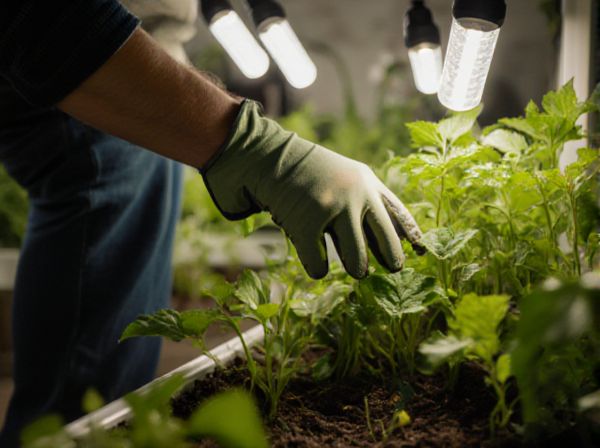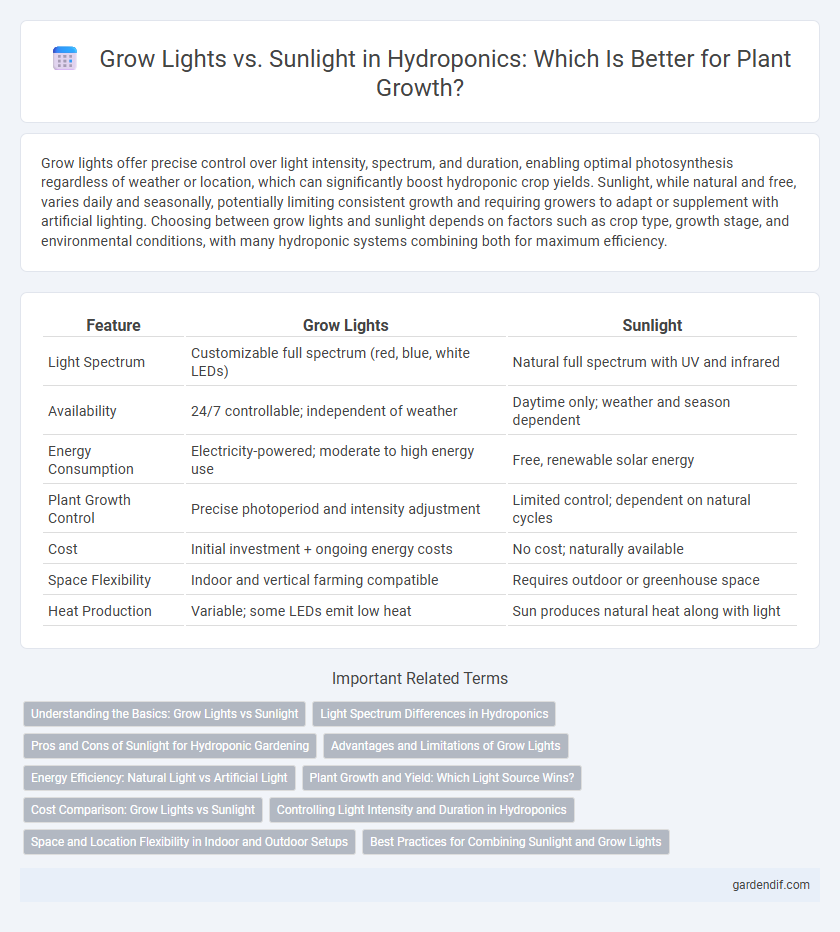
Grow Lights vs Sunlight Illustration
Grow lights offer precise control over light intensity, spectrum, and duration, enabling optimal photosynthesis regardless of weather or location, which can significantly boost hydroponic crop yields. Sunlight, while natural and free, varies daily and seasonally, potentially limiting consistent growth and requiring growers to adapt or supplement with artificial lighting. Choosing between grow lights and sunlight depends on factors such as crop type, growth stage, and environmental conditions, with many hydroponic systems combining both for maximum efficiency.
Table of Comparison
| Feature | Grow Lights | Sunlight |
|---|---|---|
| Light Spectrum | Customizable full spectrum (red, blue, white LEDs) | Natural full spectrum with UV and infrared |
| Availability | 24/7 controllable; independent of weather | Daytime only; weather and season dependent |
| Energy Consumption | Electricity-powered; moderate to high energy use | Free, renewable solar energy |
| Plant Growth Control | Precise photoperiod and intensity adjustment | Limited control; dependent on natural cycles |
| Cost | Initial investment + ongoing energy costs | No cost; naturally available |
| Space Flexibility | Indoor and vertical farming compatible | Requires outdoor or greenhouse space |
| Heat Production | Variable; some LEDs emit low heat | Sun produces natural heat along with light |
Understanding the Basics: Grow Lights vs Sunlight
Grow lights provide a controlled light spectrum tailored to optimize photosynthesis and plant growth, crucial for indoor hydroponic systems lacking natural sunlight. Sunlight offers a full spectrum of natural light, including ultraviolet and infrared wavelengths, which promote healthy plant development and influence photomorphogenesis. Understanding the intensity, duration, and spectral quality differences between grow lights and sunlight helps hydroponics growers maximize crop yield and energy efficiency.
Light Spectrum Differences in Hydroponics
Sunlight provides a full spectrum of light, including ultraviolet, visible, and infrared wavelengths, which supports all stages of plant growth in hydroponics. Grow lights, such as LED or fluorescent systems, are engineered to emit specific light spectra optimized for photosynthesis, primarily targeting blue and red wavelengths essential for vegetative growth and flowering. Tailoring the light spectrum with grow lights enhances plant development efficiency and yield in controlled hydroponic environments compared to relying solely on natural sunlight.
Pros and Cons of Sunlight for Hydroponic Gardening
Sunlight is a natural, cost-free light source that provides a full spectrum essential for photosynthesis in hydroponic gardening, promoting robust plant growth and development. However, relying solely on sunlight can limit cultivation to specific times and weather conditions, leading to inconsistent light exposure and potential temperature fluctuations that may stress plants. Its intensity varies daily and seasonally, which can hinder year-round crop production and reduce overall control compared to artificial grow lights.
Advantages and Limitations of Grow Lights
Grow lights provide consistent, controllable light spectra tailored to plant growth stages, enabling year-round hydroponic cultivation regardless of outdoor weather or seasonal changes. They offer energy efficiency advancements, reducing operational costs while enhancing photosynthesis compared to natural sunlight variability. Limitations include initial setup expense and potential heat management challenges that require careful system design to prevent plant stress.
Energy Efficiency: Natural Light vs Artificial Light
Natural sunlight provides full-spectrum energy without electricity, making it the most energy-efficient option for hydroponic systems. Artificial grow lights, such as LED and fluorescent bulbs, consume varying amounts of power, with LEDs offering the highest energy efficiency and customizable light spectra. Choosing sunlight reduces operational costs, but in controlled environments or low-light conditions, energy-efficient grow lights optimize plant growth while managing energy consumption.
Plant Growth and Yield: Which Light Source Wins?
Grow lights provide consistent, customizable light spectra that enhance photosynthesis, leading to faster plant growth and higher yields compared to natural sunlight, which varies in intensity and duration. Modern LED grow lights emit specific wavelengths optimized for chlorophyll absorption, maximizing energy efficiency and promoting robust development in hydroponic systems. While sunlight offers full-spectrum energy at no cost, controlled environments with tailored artificial lighting often produce superior crop quality and productivity in indoor hydroponic farming.
Cost Comparison: Grow Lights vs Sunlight
Grow lights for hydroponic systems typically incur upfront costs between $50 and $500, with ongoing electricity expenses averaging $20 to $50 monthly depending on wattage and usage hours. In contrast, sunlight is a free, natural light source requiring no financial investment, though its availability varies by location and season, potentially affecting crop yield consistency. Evaluating the cost-effectiveness of grow lights involves balancing electricity consumption, maintenance, and crop production benefits against the zero-cost but variable intensity of sunlight.
Controlling Light Intensity and Duration in Hydroponics
Managing light intensity and duration is crucial in hydroponic systems to optimize photosynthesis and plant growth. Grow lights offer precise control over light spectrum, intensity, and photoperiod, enabling tailored conditions regardless of external weather or seasonal changes. Sunlight provides a full spectrum but varies in intensity and duration, making it less reliable for consistent hydroponic crop production.
Space and Location Flexibility in Indoor and Outdoor Setups
Grow lights offer unparalleled space and location flexibility by enabling consistent, controlled light exposure in both compact indoor environments and unconventional spaces without natural sunlight. Sunlight, while free and full-spectrum, is limited by geographic location, weather, and daylight hours, restricting optimal plant growth to outdoor or naturally lit areas. Hydroponic systems paired with grow lights allow for year-round cultivation regardless of external conditions, maximizing productivity through precise light management.
Best Practices for Combining Sunlight and Grow Lights
Combining sunlight and grow lights in hydroponic systems enhances plant growth by providing a balanced light spectrum and extended photoperiods, essential for maximizing photosynthesis. Best practices include positioning plants to receive natural sunlight during peak hours while supplementing with LED grow lights optimized for red and blue wavelengths to stimulate vegetative growth and flowering. Monitoring light intensity and duration with timers and light meters ensures energy efficiency and prevents light stress, promoting consistent crop yields.
Grow Lights vs Sunlight Infographic

 gardendif.com
gardendif.com